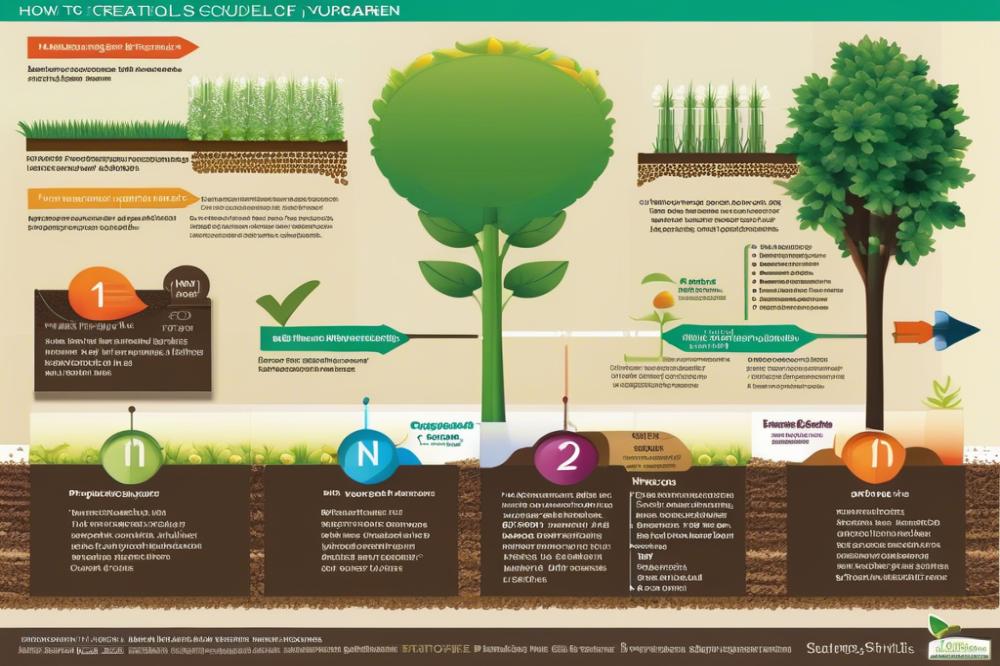Creating a fertilizing-during-different-seasons”>fertilization schedule for Your Garden
Establishing a successful garden requires more than just planting seeds and watering them. A well-thought-out fertilizing-during-different-seasons”>fertilization schedule plays a critical role in promoting healthy plant growth. Every plant thrives on different nutrients, and recognizing these needs can make a significant difference in your garden’s output.
plant nutrients such as nitrogen, phosphorous, and potassium are essential for vigor and productivity. These elements contribute to strong roots, vibrant foliage, and abundant fruits. Understanding their role in soil health is vital for anyone serious about their gardening endeavors. Healthy soil provides a foundation for plants, enabling them to reach their full potential.
Implementing a systematic approach to fertilizing can yield numerous benefits. A structured plan benefits various types of gardens, from vegetable patches to ornamental displays. By aligning nutrient timing with seasonal planting, you can create a thriving ecosystem that supports plant life. Additionally, using organic fertilizers may enhance soil health over time, promoting sustainability in your garden care.
When you take the time to develop specific fertilizing techniques, the results can be rewarding. Enhanced plant growth and improved yields directly result from a well-planned fertilization schedule. Gardening tips that focus on this aspect can lead to a more vibrant and productive plot.
Understanding plant nutrients


Every gardener must grasp the essentials of plant nutrients. Nitrogen, phosphorus, and potassium are the primary macronutrients vital for healthy growth. Each plays a distinct role in the development of plants. For instance, nitrogen promotes lush, green foliage. Phosphorus supports root development and flower production. Potassium helps with overall plant function and strengthens resistance to diseases.
Micronutrients, though needed in smaller amounts, are also crucial. Elements such as iron, magnesium, and zinc aid in various physiological processes. Without these, plants may struggle to thrive, even when macronutrients are plentiful. Understanding these nutrient roles is key to effective garden planning.
Nutrients significantly impact plant growth and development. Healthy soil supports vibrant vegetable gardens. When plants receive balanced nutrients, they grow stronger and produce better yields. Seasonal planting also benefits from a well-thought-out fertilization schedule. Timing nutrient application can enhance growth during critical stages.
The choice of fertilizers affects soil health and plant success. Organic fertilizers, derived from natural sources, improve soil structure and promote beneficial microorganisms. These fertilizers release nutrients slowly, which prevents sudden spikes and helps sustain plants over time. In contrast, synthetic fertilizers provide quick boosts of nutrients. However, they can lead to nutrient burnout if used excessively.
Effective fertilizing techniques play a vital role in garden care. Knowing when and how to apply fertilizers makes all the difference. Timing is everything when it comes to plant nutrition. Different crops may require various approaches. Gardening tips suggest observing plant responses and adjusting nutrient delivery accordingly.
Assessing Soil Health


Understanding soil health is key to effective garden planning. Many methods exist for testing soil quality and nutrient levels. A simple soil test kit can provide important data. Kits are available at garden stores or online. You can also send samples to local agricultural extension services for analysis. This approach often offers detailed insights into essential plant nutrients.
Soil pH plays a significant role in nutrient availability. Most plants thrive in a slightly acidic to neutral range, generally between 6.0 and 7.0. When pH levels fall outside of this range, nutrients may become locked away, depriving plants of what they need. Alkaline soil can render certain nutrients like iron ineffective, causing deficiencies. Adjusting the pH should be part of your strategy for strengthening soil health.
Before establishing a fertilization schedule, consider techniques for improving soil health. Incorporating organic fertilizers can enhance nutrient content naturally. These materials break down into essential nutrients gradually, fostering healthy plant growth over time. Adding compost is another excellent method. This provides beneficial microorganisms and improves soil structure. Techniques such as crop rotation and cover cropping can also promote healthy soil ecosystems.
Seasonal planting should align with these improvements. Understanding when to fertilize according to plant needs makes a big difference. Pay attention to nutrient timing as plants grow and their requirements change. Different plants may have varying demands at different stages of growth. Apply these gardening tips to create a thriving vegetable garden full of vitality and productivity.
Creating Your Fertilization Schedule


When planning your garden, several factors must be taken into account. The types of plants you choose play a crucial role. Different species have specific needs for plant nutrients. Understanding these differences helps in effective garden planning.
Growing conditions also matter greatly. Some plants thrive in rich soil, while others prefer sandy or loamy environments. Soil health influences how well plants can absorb nutrients. Therefore, testing your soil prior to fertilizing is always a smart choice.
Seasonal planting affects when and how often to apply fertilizers. Spring and summer are typically the most active times for plant growth. Applying nutrients during these months often yields the best results. Conversely, fall may call for different techniques, especially for winter crops.
Steps to Develop a Customized Fertilization Plan
Begin with a soil test. This measures essential components like pH and nutrient levels. Once you understand the soil’s condition, choose the right type of fertilizer. Organic fertilizers can improve soil health and provide slow-release nutrients.
Next, list all the plants in your vegetable garden. Note their specific nutrient needs. Some may require more nitrogen, while others benefit from phosphorus or potassium. This information guides your fertilizing techniques.
Create a schedule based on your findings. Divide the year into key growing phases. Make adjustments depending on seasonal planting times. Regular monitoring of plant growth will help refine your plan.
Importance of Timing and Frequency in Nutrient Application
Timing is everything when it comes to nutrient application. Plants absorb nutrients more effectively at certain stages of growth. Fertilizing too early or late can hinder their development. Divide applications into smaller, regular doses instead of one large one.
Frequency must align with the growing cycle. During peak growth periods, more frequent feeding may be necessary. Adapting to changes in weather can also impact your fertilization schedule. Keep an eye on rainfall, temperature, and other environmental factors.
Gardening tips and adjustments based on your observations will go a long way. Each garden is unique, and understanding how your plants respond to nutrients over time helps make informed adjustments. Success will depend on your commitment to these practices.
Fertilizing Techniques


Understanding how to effectively add nutrients to your garden is crucial for healthy plant growth. There are several common fertilizing methods that gardeners use to meet the needs of their plants. Broadcasting is one popular technique. In this method, fertilizers are spread evenly over the soil surface before or during planting. Side-dressing, on the other hand, involves applying fertilizers to the soil alongside growing plants. This technique is often used when plants need a nutrient boost during their growth cycle. Foliar feeding is another option. By spraying a nutrient solution directly onto the leaves, gardeners can provide immediate access to plant nutrients.
When considering fertilizers, a gardener can choose between organic fertilizers and synthetic fertilizers. Organic options come from natural sources, such as compost or animal manure. They improve soil health and support a balanced ecosystem in the garden. Many gardeners prefer organic due to its environmental benefits. In contrast, synthetic fertilizers are chemically manufactured. While they can work quickly and provide concentrated nutrients, they may lead to problems like soil degradation if used improperly. The choice between these types often depends on personal values, the type of plants grown, and garden planning strategies.
Nutrient timing plays a significant role in maximizing the effectiveness of any fertilizing technique. Gardeners should align their fertilizer applications with seasonal planting schedules. For instance, applying nutrients just before the growing season ensures plants have ample food as they begin to sprout. It is also important to pay attention to the specific needs of different plant varieties. Some vegetables require more nutrients during certain stages of growth than others. Understanding these needs helps in crafting an effective fertilization schedule.
Integrating fertilization with other gardening tasks can improve your gardening experience. For example, when preparing the soil for planting, mixing compost into the ground can supply vital nutrients. This tactic not only enriches the soil but also supports moisture retention. Mulching around established plants can also help maintain soil health. Using organic mulch can break down over time, slowly feeding your plants. New gardeners should keep these tips in mind as they develop their skills. Learning how to approach fertilization wisely and consistently contributes to vibrant growth in a vegetable garden.
Seasonal Considerations
Creating a fertilization schedule requires attention to the changing seasons and the different needs of various plants. Adjusting your fertilization routine based on seasonal planting will help you achieve optimal growth. For example, spring planting typically involves a focus on young plants. These seedlings often require different nutrients compared to mature plants found in fall crops.
Different vegetables thrive during specific times of the year. Cool-season crops, like spinach and lettuce, benefit from fertilization as they begin to grow in early spring. On the other hand, warm-season fruits, such as tomatoes and peppers, have distinct nutrient requirements. This variation demands careful planning to match the right type of fertilizer to the right plants.
Nutrient timing holds significant importance throughout the growing season. Early fertilization encourages robust root development, which is crucial for later stages of plant growth. Mid-season fertilizer applications can boost nutrient levels in the soil, especially after heavy rains or watering. At this point, the health of your soil can significantly impact how well your plants perform.
Utilizing organic fertilizers could also be a choice depending on personal gardening preferences. Organic options often release nutrients more gradually, giving your plants a steady supply. Not all fertilizers are suitable for every crop, so understanding their unique needs is vital for success. Pay attention to the specific nutrient ratios when choosing a fertilizer.
Maintaining soil health is an ongoing goal during the different seasons. Soil composition can change due to various factors, including moisture and temperature. Regular testing of soil helps in tracking nutrient levels. This way, you can tailor your fertilizing techniques to support healthy plant growth.
Garden planning involves knowing when to fertilize. Mapping out these schedules not only helps in keeping an eye on your plants but also makes gardening easier. With insightful gardening tips, you can time applications just right, ensuring that your plants absorb what they need at peak growth times. Tracking seasonal changes can be as simple as noting when you plant your seeds or how long your crops take to mature.
Gardening Tips for Effective Fertilization
Applying fertilizers correctly is essential for maximizing plant health. First, select the right type of fertilizer for your specific plants. Organic fertilizers can enrich the soil health and promote beneficial microorganisms. Testing the soil will help determine which plant nutrients are needed. This knowledge guides you in choosing the correct fertilizer. Timing is also crucial. Certain nutrients are best absorbed at specific growth stages, so consider nutrient timing carefully.
Many gardeners make mistakes when fertilizing their gardens. Over-fertilizing is a common error. It can lead to nutrient burn, harming your plants rather than helping them. Under-fertilizing is often just as problematic, as plants may not get enough nutrients for robust growth. Furthermore, not paying attention to the specific needs of different plants can cause imbalances. Different types of vegetables have varying nutrient requirements, so adjust your approach accordingly.
Monitoring Plant Health
Regular observation of your plants is essential. Look for signs of nutrient deficiency, such as yellowing leaves or stunted growth. These signals indicate that adjustments to your fertilization might be necessary. Additionally, consider seasonal planting as another factor. Different times of the year can affect how plants utilize nutrients. As the season changes, be ready to modify your fertilizing techniques accordingly.
Keep a gardening journal to track your fertilization schedule and plant reactions. This will help you in your garden planning for future seasons. Documenting your observations can inform better decisions next time. Incorporating these gardening tips can lead to a thriving vegetable garden.
Wrapping Up Your Fertilization Journey
Creating a tailored fertilization schedule is essential for any gardener. It helps you respond to the specific needs of your plants and the health of your soil. Proper timing and suitable nutrients can completely transform your garden’s yield.
Feel free to experiment with different techniques and timings. Every garden has its own personality, and what works perfectly for one may not fit another. Observe how your plants react to various fertilizers and schedules. Making adjustments based on those observations is a valuable part of the gardening process.
Long-term benefits come from maintaining a focus on soil health and providing the right plant nutrients. Strong soil supports not only your current plants but also lays the groundwork for future growth. A thriving garden requires patience and care, but the rewards are worth the effort. Enjoy watching your garden flourish with the attention it deserves!



